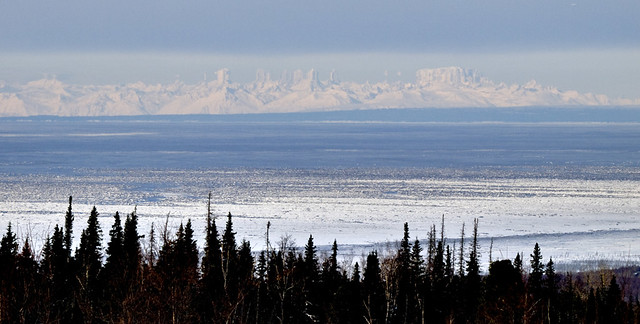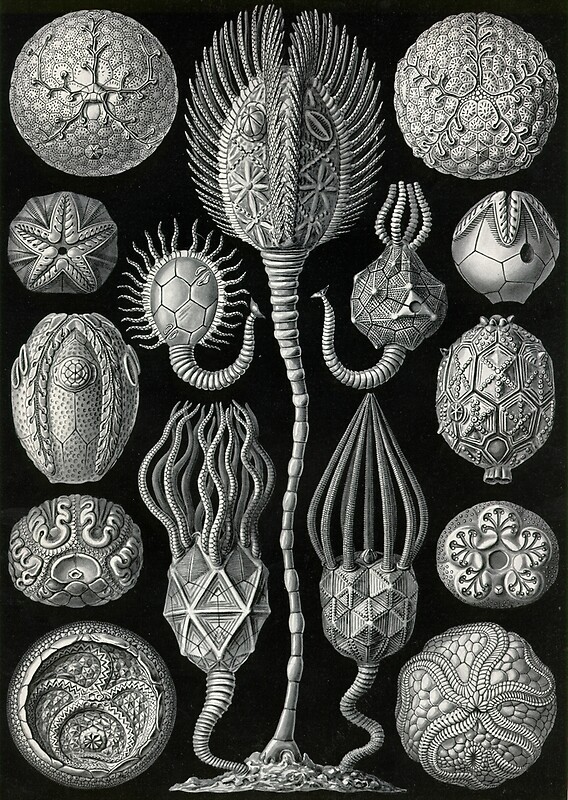Fata Morgana
I was reading an 1875 edition of The Open Polar Sea, a book about an 1860 expedition toward the North Pole. The author mentions certain illusions that reminded him of cities in the ice:
This reminded me of a scene from The Mountains of Madness:
I looked up the image by Scoresby that Lovecraft mentions, and this appears to be it:
The illusion is causing certain parts of the mountains to be duplicated repeatedly, either inverted or right-side up. This is known as a Fata Morgana. Here are links to a couple on Flickr:
https://www.flickr.com/photos/-laurenparker/6372445777/sizes/l
https://www.flickr.com/photos/frankloo2/3371590079/
Fata Morganas have been held responsible for stories of disappearing islands, flying ships, hidden civilizations, and so forth.
These reminded me of some concept art by Robyn Miller for a Myst game that was never built:
I've been playing with deep style transfer, to cause AI to hallucinate cities in mountains. Here is one:
"The atmosphere had a rare softness, and throughout almost the entire day there was visible a most remarkable mirage or refraction, — an event of very frequent occurrence during the calm days of the Arctic summer. The entire horizon was lifting and doubling itself continually, and objects at a great distance beyond it rose as if by strange enchantment and stood suspended in the air, changing shape with each changing moment. Distant icebergs and floating ice-fields, and coast-lines and mountains were thus brought into view ; sometimes preserving for a moment their natural shapes, then widening or lengthening, rising and falling as the wind fluttered or fell calm over the sea. The changes were as various as the dissolving images of a kaleidoscope, and every form of which the imagination could conceive stood out against the sky. At one moment a sharp spire, the prolonged image of a distant mountain-peak, would shoot up; and this would fashion itself into a cross, or a spear, or a human form, and would then die away, to be replaced by an iceberg which appeared as a castle standing upon the summit of a hill, and the ice-fields coming up with it flanked it on either side, seeming at one moment like a plain dotted with trees and animals; again, as rugged mountains; and then, breaking up after a while, disclosing a long line of bears and dogs and birds and men dancing in the air, and skipping from the sea to the skies. To picture this strange spectacle were an impossible task. There was no end to the forms which appeared every instant, melting into other shapes as suddenly. For hours we watched the "insubstantial pageant," until a wind from the north ruffled the sea; when, with its first breath, the whole scene melted away as quickly as the "baseless fabric" of Prospero's "vision;" and from watching these dissolving images, and wooing the soft air, we were, in a couple of hours, thrashing to windward through a fierce storm of rain and hail, under closereefed sails."
This reminded me of a scene from The Mountains of Madness:
"This mood undoubtedly served to aggravate my reaction to the bizarre mirage which burst upon us from the increasingly opalescent zenith as we drew near the mountains and began to make out the cumulative undulations of the foothills. I had seen dozens of polar mirages during the preceding weeks, some of them quite as uncanny and fantastically vivid as the present sample; but this one had a wholly novel and obscure quality of menacing symbolism, and I shuddered as the seething labyrinth of fabulous walls and towers and minarets loomed out of the troubled ice-vapours above our heads.
The effect was that of a Cyclopean city of no architecture known to man or to human imagination, with vast aggregations of night-black masonry embodying monstrous perversions of geometrical laws and attaining the most grotesque extremes of sinister bizarrerie. There were truncated cones, sometimes terraced or fluted, surmounted by tall cylindrical shafts here and there bulbously enlarged and often capped with tiers of thinnish scalloped discs; and strange, beetling, table-like constructions suggesting piles of multitudinous rectangular slabs or circular plates or five-pointed stars with each one overlapping the one beneath. There were composite cones and pyramids either alone or surmounting cylinders or cubes or flatter truncated cones and pyramids, and occasional needle-like spires in curious clusters of five. All of these febrile structures seemed knit together by tubular bridges crossing from one to the other at various dizzy heights, and the implied scale of the whole was terrifying and oppressive in its sheer giganticism. The general type of mirage was not unlike some of the wilder forms observed and drawn by the Arctic whaler Scoresby in 1820; but at this time and place, with those dark, unknown mountain peaks soaring stupendously ahead, that anomalous elder-world discovery in our minds, and the pall of probable disaster enveloping the greater part of our expedition, we all seemed to find in it a taint of latent malignity and infinitely evil portent.
I was glad when the mirage began to break up, though in the process the various nightmare turrets and cones assumed distorted temporary forms of even vaster hideousness. As the whole illusion dissolved to churning opalescence we began to look earthward again, and saw that our journey’s end was not far off."
I looked up the image by Scoresby that Lovecraft mentions, and this appears to be it:
The illusion is causing certain parts of the mountains to be duplicated repeatedly, either inverted or right-side up. This is known as a Fata Morgana. Here are links to a couple on Flickr:
https://www.flickr.com/photos/-laurenparker/6372445777/sizes/l
https://www.flickr.com/photos/frankloo2/3371590079/
Fata Morganas have been held responsible for stories of disappearing islands, flying ships, hidden civilizations, and so forth.
These reminded me of some concept art by Robyn Miller for a Myst game that was never built:
I've been playing with deep style transfer, to cause AI to hallucinate cities in mountains. Here is one:
In the desert, you tend to get "inferior mirages," where the ground is hotter than the air above it, and so the refraction looks like a reflection from below-- like a lake. This is the same thing that happens on a hot road in the summer. But in polar regions, you often get an inversion, where the ice sheet is colder than the air above it. This creates a "superior mirage" where the image of the object appears above the object. A Fata Morgana is caused by mixing layers of this cold air and warmer air, which causes essentially repeated superior mirages on top of each other.
Fata Morgan comes from Italian for Morgan Le Fay, the magical antagonist from the Arthurian legends.
Here's another deep style transfer image:
Apparently Lovecraft got a lot of his good ideas by looking at great illustrations and making up stories about them. Here are a few of Ernst Haeckel's illustrations that closely match some of his descriptions of the creatures in this story:











Comments